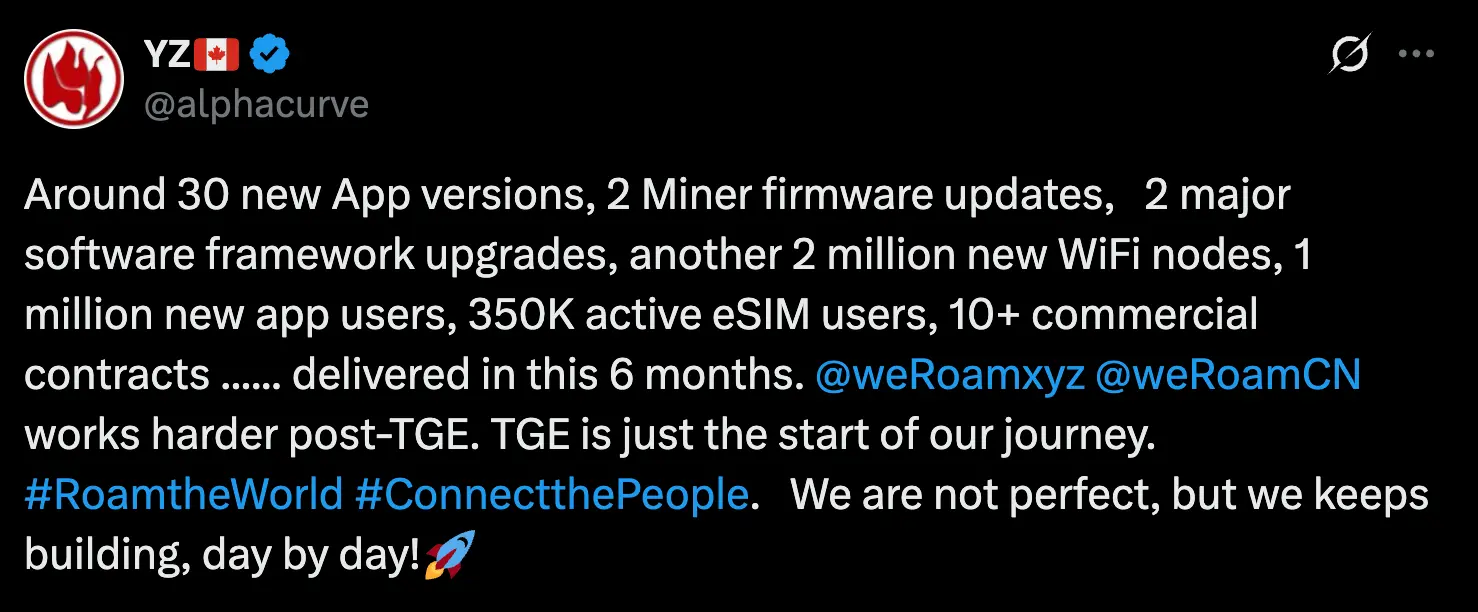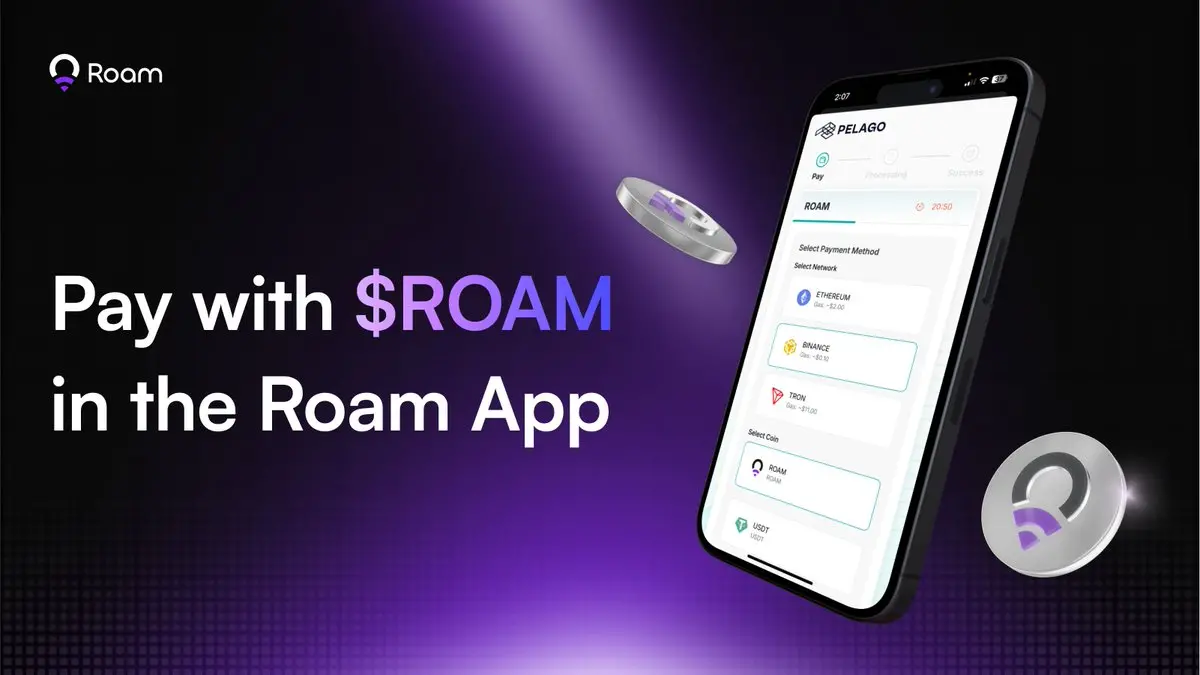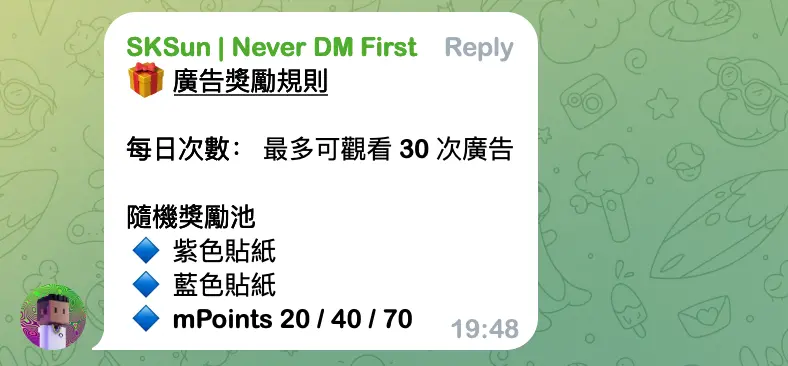September 6 marks the six-month anniversary of Roam's TGE, and the official team has released a special edition commemorative sticker.
Project co-founder YZ shared a set of key data on social media platform X, reflecting on the development progress over the past six months: a total of 30 version updates, the addition of 2 million WiFi nodes, and the implementation of applications for 350,000 eSIM users.
At the same time, Roam has recently launched several important feature updates, including a complete overhaul of App 2.0, the official launch of the native token ROAM payment function, the introduction of a super staking pool for mining machines, and a systematic adjustment of the points reward mechanism. This series of actions signifies that the project is strategically transitioning from a pure infrastructure construction phase to an ecological value capture phase.

(Roam co-founder YZ tweeted a review of the team's development journey post-TGE: 30 version updates, 2 hardware upgrades, 2 major software architecture upgrades, 2 million new WiFi nodes, 1 million new registered users, 350,000 active eSIM users, 10 business contracts signed… TGE is just the beginning. Source: X)
From "Useful Tool" to "My World": A User-Centric Strategic Upgrade
For Roam's global community of 3 million users, the recent major update of App 2.0 is much more than just a visual enhancement; it represents an identity upgrade—users leap from being mere "users" of the network to becoming participants in the entire Roam ecosystem. The core of this upgrade lies in the ecological center entry located in the center of the bottom navigation bar.
1. From "Multiple Tools" to "Aggregated Ecosystem"
Previously, users often used Roam in the following ways:
Opening the app to connect to OpenRoaming WiFi when needing internet access.
Purchasing a global eSIM package before traveling abroad.
Daily check-ins to accumulate points, occasionally participating in community Quest tasks to earn extra points.
Once points accumulated to a certain level, participating in the burn pool to exchange for $ROAM and engage in reverse burn arbitrage.
While these functions are good, they are disjointed. Users felt more like they were using a "toolbox" rather than being part of a "community."
The 2.0 version update completely changed this. The entry located in the center of the bottom navigation bar acts as the "gateway" for users to enter the Roam world. Here, all user actions—connecting to the network, consuming content, participating in governance, earning rewards—are interconnected and recorded under a unified digital identity.
For users, this means:
Enhanced sense of belonging: Every connection and participation adds value to their identity. This shift transforms users from passive consumers to active co-builders.
Unprecedented convenience: Users are spared the cumbersome steps of searching for functions in complex menus. Want to know what $ROAM tokens can do? Curious about recent community activities? Want to try out the new AI assistant? All answers can be unlocked with a single click. This greatly lowers the threshold for exploring the ecosystem and encourages users to try exciting features they may have previously missed.
2. From "Earning Points" to "Planning Digital Assets"
Recently, Roam's points rewards have also been comprehensively increased, complementing the launch of the ROAM payment function, making the user reward system more intuitive, useful, and imaginative.

ROAM has thus become the "hard currency within the ecosystem." Tokens earned by users through contributing network resources can now be directly used to pay for eSIM packages and recharge phone credits. This instantly endows the incentives with real purchasing power, forming a closed loop of "contribution-reward-consumption." This immediate feedback loop can significantly enhance users' motivation to participate in network construction.
The reward mechanisms are more diverse, catering to different user preferences. Whether users prefer stable returns (through super staking, locking, etc.), high-frequency interactions (daily check-ins, watching incentive ads), or pursuing high-value returns (participating in reverse burns to obtain USDT), different types of users can find suitable ways to participate. This way, both "casual players" and "deep players" in the community can find their place and collectively strengthen the network.

(New reward mechanism Watch to Earn: Watch 30-60 seconds of incentive ads, and upon completion, randomly receive points or epic stickers | Screenshot source: Roam Official TG Community)
More importantly, the new points system lays the foundation for future on-chain points through deflationary mechanisms and value anchoring, giving points stronger asset attributes. They can not only circulate in cross-project activities like Bitbang and Paparun but can also be expanded to more application scenarios such as CDN and address-based IP services after going on-chain, truly achieving a transformation from simple points to digital assets.
3. A Leap in Community Cohesion: From "Lonely Individuals" to "Strong Collectives"
For a distributed network with millions of nodes and billions of verification actions, community cohesion is its most valuable asset. The 2.0 update cleverly enhances this cohesion through product design.
A shared "digital community": Features like Roam Club (events, leaderboards, tasks) have been elevated to the forefront, making users' contributions and rankings visible. This stimulates healthy competition and a sense of community honor, making users proud of their community or their position on the leaderboard.
Transparent shared mission: The new points and staking systems are more transparent, allowing every node operator to clearly understand how their contributions are measured and how rewards are generated. This sense of fairness and trust is the foundation for the community's willingness to sustainably contribute their hardware over the long term.
In summary, the Roam 2.0 upgrade goes far beyond functional aggregation; it is a redefinition of identity from "tool" to "ecosystem," allowing every connection and participation by users to translate into value accumulation within the ecosystem, collectively building an open, inclusive, and community-built network future.
More Than an Upgrade: A Revolution in Connection and Value
The pace of progress Roam has made in the 180 days following the TGE is impressive; Roam has transformed the concepts in its white paper into the world's largest open wireless network. With the comprehensive upgrade of App 2.0, Roam is entering a new stage of development.
The release of App 2.0, along with the accompanying economic model upgrade, signifies that the project is transitioning from the "infrastructure construction" phase to the "ecological value capture" phase. The two core product lines—OpenRoaming WiFi and global eSIM services—have formed a good synergy: 6 million nodes provide physical layer coverage, 3 million users create network effects, and Roam eSIM with 350,000 active users in over 160 countries proves the feasibility of its business model, showcasing Roam's forward-looking layout for future communications.
From the perspective of industry development timing, Roam is perfectly positioned at two key nodes: first, the hardware benefits brought by the iPhone 17 fully embracing eSIM, and second, the market window opened by the explosive demand from global digital nomads and cross-border business needs. But what is even more noteworthy is that what Roam is doing transcends traditional connection services—by transforming user connection behaviors into AI data assets through privacy protection technology, this narrative space is much larger than mere network services.
Completing 30 iterative updates in 180 days, this pace even surpasses many Web2 teams. From hardware upgrades to architectural restructuring, and now to economic model optimization, Roam is building a complete flywheel: more nodes → better network → more users → higher token demand → more node investment. If this closed loop can continue to operate, its network value will exhibit exponential growth.
Roam's value lies not only in technical implementation but also in its validation of a hypothesis: the Web3 economic model can indeed coordinate global participants to jointly build and operate physical infrastructure. While other projects are still discussing decentralization theory, Roam has already enabled 3 million users to access a truly community-built network service.
The future challenge lies in how to balance network expansion, token economics, and regulatory compliance. However, if the current momentum can be maintained, Roam is likely to become the first Web3 infrastructure project to achieve large-scale commercial use.
免责声明:本文章仅代表作者个人观点,不代表本平台的立场和观点。本文章仅供信息分享,不构成对任何人的任何投资建议。用户与作者之间的任何争议,与本平台无关。如网页中刊载的文章或图片涉及侵权,请提供相关的权利证明和身份证明发送邮件到support@aicoin.com,本平台相关工作人员将会进行核查。




